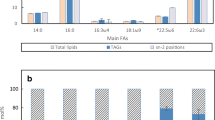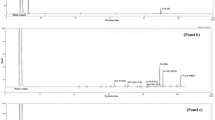Abstract
Production of ω-3 fatty acid concentrates from seal blubber oil (SBO) and menhaden oil (MHO) upon enzymatic hydrolysis by Candida cylindracea lipase was optimized. In this process, the content of total ω-3 fatty acids, Y 1; eicosapentaenoic acid, Y 2; and docosahexaenoic acid, Y 3, in the final product was maximized. A three-factor central composite rotatable design was used to study the effect of enzyme concentration (X 1), reaction time (X 2), and reaction temperature (X 3). Second-order polynomial regression models for Y 1, Y 2, and Y 3 were employed to generate response surfaces. After hydrolysis, a maximum of 54.3% total ω-3 fatty acids was obtained from SBO at an enzyme concentration of 308 U/g oil, a reaction time of 40 h, and a reaction temperature of 37°C. Similarly, a maximum of 54.5% total ω-3 fatty acids was obtained from MHO at an enzyme concentration of 340 U/g oil, a reaction time of 45 h, and a reaction temperature of 38°C.
Similar content being viewed by others
References
Wanasundara, U.N., and F. Shahidi, Lipase-Assisted Concentration of Omega-3 Polyunsaturated Fatty Acids in Acylglycerol Form from Marine Oils, J. Am. Oil Chem. Soc. 75:945–951 (1998).
Yamane, T., Enzyme Methodology for the Lipid Industry: An Engineering Overview, Ibid.:1659–1662 (1987).
Thompson, D.R., Product Optimization, J. Food Process. Preserv. 6:1–13 (1982).
Box, G.E.P., and K.B. Wilson, On the Experimental Attainment of Optimum Conditions, J. Roy. Statist. Soc. 13:1–45 (1951).
Hunter, J.S., Determination of Optimum Operating Conditions by Experimental Methods, Ind. Qual. Cont. 15:6–11 (1959).
Hill, W.J., and J.S. Hunter, A Review of Response Surface Methodology: A Literature Survey, Technometrics 8:571–590 (1966).
Lee, C.C., and R.C. Hoseney, Optimization of the Fat-Emulsifier System and the Gum-Egg White-Water System for a Laboratory-Scale Single Stage Cake Mix, Cereal Chem. 59:392–396 (1982).
Shieh, C.J., C.C. Akoh, and P.E. Koehler, Four-Factor Response Surface Optimization of the Enzymatic Modification of Triolein to Structured Lipids, J. Am. Oil Chem. Soc. 72:619–623 (1995).
Rustom, I.Y.S., M.H. Lopez-leiva, and B.M. Nair, Optimization of Extraction of Peanut Proteins with Water by Response Surface Methodology, J. Food Sci. 56:1660–1663 (1991).
Wanasundara, P.K.J.P.D., and F. Shahidi, Optimization of Hexametaphosphate-Assisted Extraction of Flaxseed Proteins Using Response Surface Methodology, Food Chem. 61:604–607 (1996).
Montgomery, D.C., Design and Analysis of Experiments, 2nd edn., John Wiley and Sons, New York, 1984, pp. 445–470.
Hoshino, T., T. Yamane, and S. Shimuzu, Selective Hydrolysis of Fish Oils by Lipase to Concentrate ω3 Polyunsaturated Fatty acids, Agric. Biol. Chem. 54:1459–1467 (1990).
Shahidi, F., U.N. Wanasundara, and N. Brunet, Oxidative Stability of Oil from Blubber of Harp Seal (Phoca groenlandica) as Assessed by NMR and Standard Procedures, Food Res. Inter. 27:555–562 (1994).
Box, G.E.P., The Exploration and Exploitation of Response Surfaces, Some General Considerations and Examples, Biometrics 10:16–60 (1954).
Cornell, J.A., How to Apply Surface Response Methodology, ASQC Basic Reference in Quality Control, ASQC, Milwaukee, 1992, pp. 1–60.
Joglekar, A.M., and A.T. May, Product Excellence Through Design of Experiments, Cereal Food World 32:857–861 (1987).
SAS User’s Guide: Basic Statistics, SAS Institute Inc., Cary, 1990.
Wanasundara, U.N., and F. Shahidi, Positional Distribution of Fatty Acids in Triacylglycerols of Seal Blubber Oil, J. Food Lipids 4:51–64 (1997).
Author information
Authors and Affiliations
Corresponding author
About this article
Cite this article
Wanasundara, U.N., Shahidi, F. Concentration of ω-3 polyunsaturated fatty acids of marine oils using Candida cylindracea lipase: Optimization of reaction conditions. J Amer Oil Chem Soc 75, 1767–1774 (1998). https://doi.org/10.1007/s11746-998-0330-2
Received:
Accepted:
Issue Date:
DOI: https://doi.org/10.1007/s11746-998-0330-2




